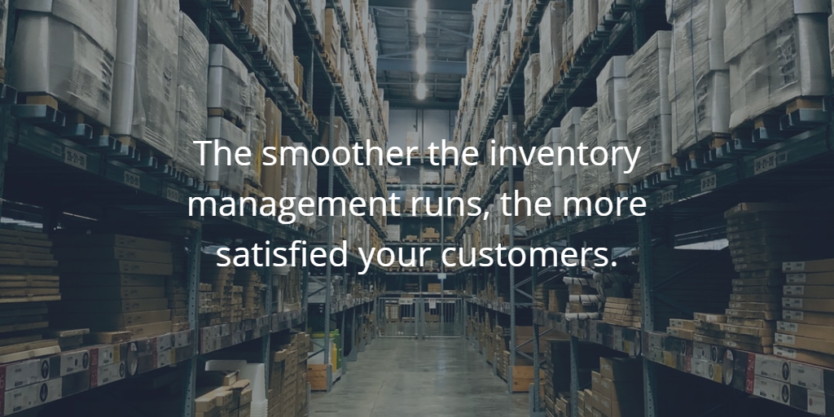Online shops have so many processes running in the background that you as a shop owner must never lose track of. Procurement, determination of requirements, logistics, transport, and storage – the smoother the inventory management system runs, the more satisfied your customers are. Most shop systems offer various basic functions to manage orders or stocks to a certain degree.
The larger your online shop and the more categories and products you offer, the more difficult it is to keep an eye on all processes. And at some point, the lack of system depth takes its toll on a crucial resource: the person responsible.
The shop is buzzing and your employees have more and more to do. However, the margin per item sold is sinking. More personnel is recorded, but the profit does not increase linearly with it. Costs are driven up and margins are reduced.
This is why many WooCommerce shops use software that can map the complexity of inventory management in its entirety. This includes so-called inventory management and ERP systems. If you start using such a system early enough, a difference of ten or 1,000 parcels a day will not affect the commercial department but only your shipping department.
The differentiation between ERP and inventory management systems (IMS) is not easy and each program offers different advantages and disadvantages. That’s why we will discuss the possible ERP and IMS for WooCommerce in this article, explaining the difference and exploring our favorite systems.
The difference between ERP and IMS
On a basic level, the distinction is simple: inventory management systems (IMS) concentrate on the products, their procurement, determination of requirements, transport and warehousing. The focus here is on material flow.
ERP software is larger and more complex and is therefore preferred by large companies. ERP stands for Enterprise Resource Planning. ERP software relies on comprehensive resource planning, efficiently uses all resources, from goods to capital to personnel, and improves business processes and cross-departmental processes in the long term.
An example for such an ERP system is SAP, which is widely used in large companies. For most WooCommerce shops, however, SAP would be complete overkill. Whether a pure IMS or an extension with ERP functions make sense for your shop depends on how large your shop is, what plans you have for it in the future, and what the system offers.
The Best ERP and IMS for WooCommerce
Herein lies the true difficulty: most systems are not pure IMS or complete ERP systems. Therefore we recommend not to search for one or the other for your WooCommerce shop, but to check the following systems for the best fit for your shop.
WooCommerce Stock Manager
Price: free
System type: IMS
Core functions: Basic inventory management
WooCommerce Stock Manager is ideal for uncomplicated inventory management on a small scale. This free WordPress plugin manages stock levels, delivery backlogs, purchase, and sales prices, as well as the weights of your products and their variants.
WooCommerce Stock Manager allows you to filter products according to various criteria, such as product type, category, and stock status. The plugin also synchronizes with Excel for easy data export, preparation, and import.
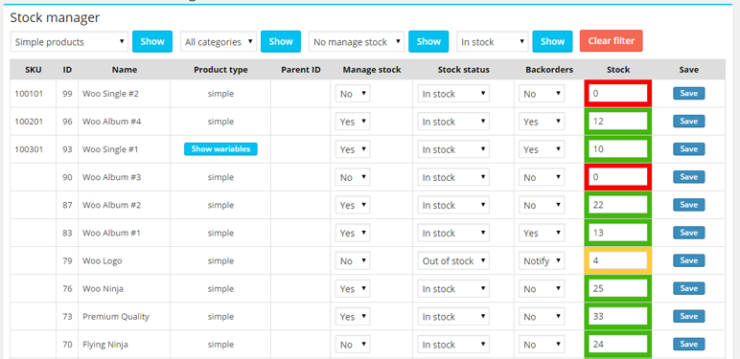
TradeGecko
Price: from 79 USD/month
System type: IMS
Core functions: Extensive coverage of inventory management for several shops
TradeGecko works with WooCommerce to synchronize your online store with a user-friendly IMS. It controls your inventory in multiple locations, manages sales and orders, and automates demand forecasting.
TradeGecko provides detailed reporting and analysis for valuable insight into your growing customer base and profits. You can even integrate more than one WooCommerce shop. TradeGecko manages to remain easy to use.
Here is a list of TradeGecko features:

In the Lite version, TradeGecko is available from 79 USD per month. In addition, TradeGecko offers several other price scales:
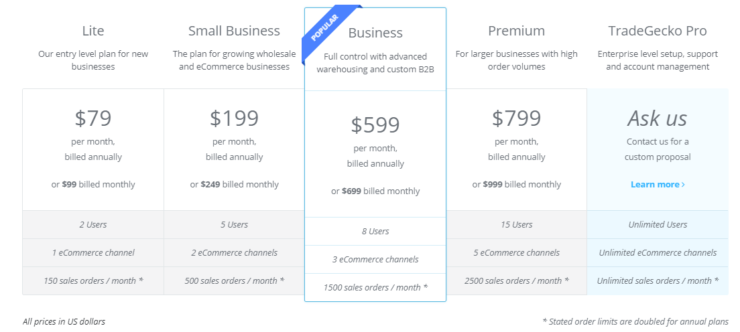
Stitch by Stitchlabs
Price: from 499 USD/month
System type: IMS with ERP extensions
Core functions: Extensive coverage of enterprise resource planning across a wide range of platforms
Stitch is another good option for WooCommerce. It automatically synchronizes your inventory, orders product data across multiple sales channels, suppliers and fulfillment points.
It’s a great tool for online stores that sell on multiple platforms and need a centralized view of inventory. Stitch can integrate with marketplaces like Amazon and eBay. For example, if a customer orders your products on Amazon or eBay, and at the same time also in your WooCommerce shop, all orders are automatically merged and synchronized by Stitch.
Here you can see an excerpt of the numerous features that Stitch has to offer:

Stitch is also very adaptable in price. Three different packages are offered with an increasing number of features, which vary in price depending on the number of products in your shop. For up to 2,000 orders per month, the package prices are as follows:
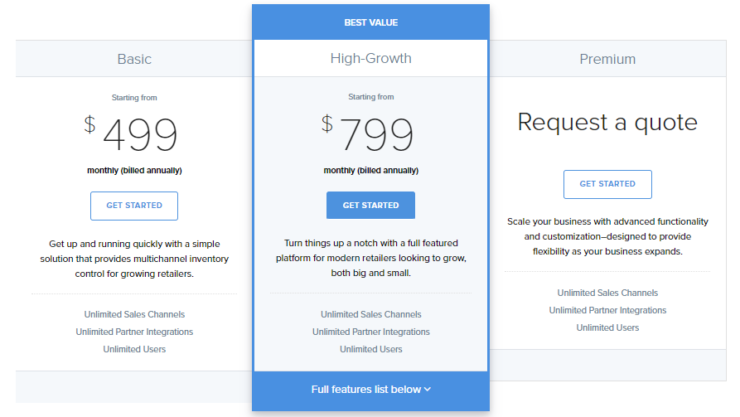
Orderhive
Price: from 99 USD/month
System type: IMS
Core functions: Extensive coverage inventory management, stock & order management, automation Dropshipping
Orderhive integrates with all major eCommerce platforms such as WooCommerce and Shopify, as well as with many other systems such as Stripe, Amazon, eBay, and carriers such as UPS, FEDEX and USPS.
With Orderhive, you can manage multiple distribution channels, centralize inventory, ship and track orders, and automate dropshipping. In addition, Overdrive offers wholesale management and a robust analysis dashboard to simplify the performance improvement of your WooCommerce shop.
Orderhive also has a number of other useful features:
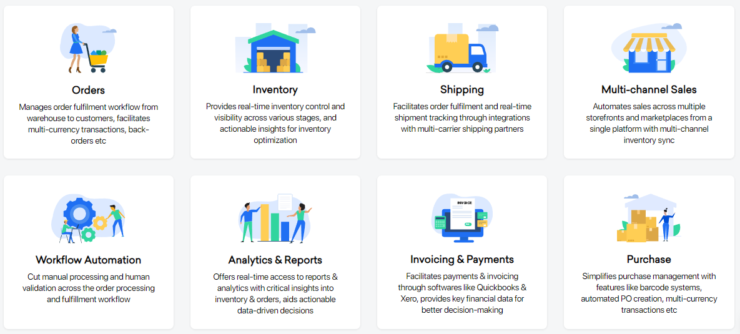
And this at different monthly prices, depending on the extent to which you sell your products:

BillBee
Price: from 0,07€/order up to max. 39€/month for one sales channel
System type: IMS
Core functions: Comprehensive coverage of inventory management, easy-to-use order processing, and automation solution for multiple sales channels
Billbee is our personal favorite among the ERP and IMS for German WooCommerce shops. This starts with simple, intuitive handling, continues with the comprehensive IMS functions and ends with the flexible, unique price model.
Billbee communicates with marketplaces like DaWanda, Etsy, Amazon, Ebay, Rakuten and online shops like VersaCommerce, WooCommerce, and Shopware.
Billbee offers among other things
- automatic order import, stock comparison, processes via rules
- Creation & dispatch of invoices, delivery notes, quotations, ABs and labels
- Creation of shipping documents for DHL, DPD, UPS, Hermes and Deutsche Post
- Fulfillment and Dropshipping with Amazon FBA and other providers
Here you can see Billbee’s own overview of its numerous features:
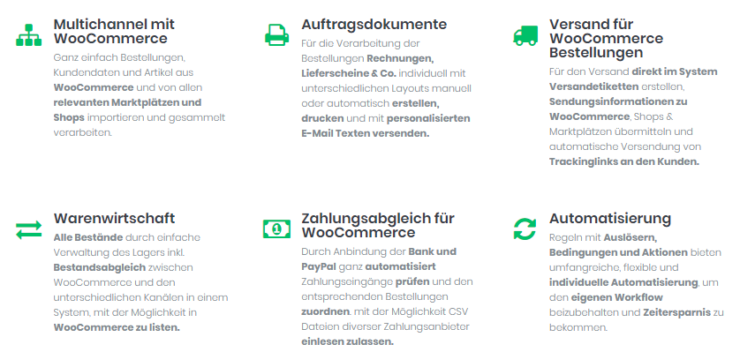
What we particularly like: Billbee only charges per sale. So you only pay for orders that have actually been placed. For a single sales channel, you pay 0.07€/order, but only up to a maximum of 39€/month.
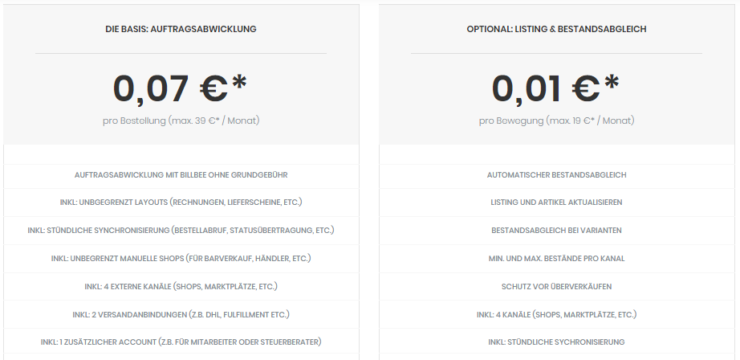
Here Billbee offers a slider to calculate your possible costs.
More profit in WooCommerce with the right ERP or IMS
As you can see, different systems serve different needs for WooCommerce shop operators. Free plugins are usually sufficient for a simple IMS – but do they benefit your shop in the long run?
One thing is clear: the use of an ERP or IMS supports your processes, especially with large numbers of orders, because it automates the processes and tasks of your employees. It thus keeps costs low and your margin high.
But the right ERP or IMS for WooCommerce is not the only way to increase sales in your shop. Contact us here and let’s discuss solutions for your business challenges.

